An Introduction to the "Nengmian" of the Wraith Department: Generating, Intermediate, and True
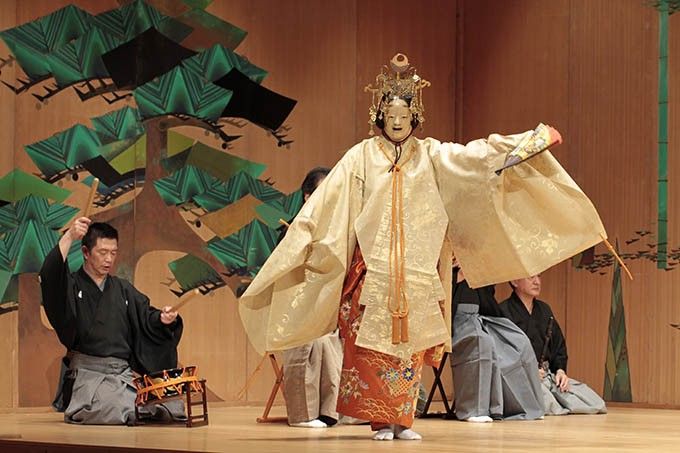
"Noh"* is a traditional Japanese drama performed with a mask on.
Its name started from the Heian period (794-1185) until the Edo period (1603-1868), where "no" was called Saru-raku (さるがく) or Sanraku (さんがく). After the Meiji Restoration (1968), Saru Music declined. In Meiji 14 (1881), in order to revitalize Saruraku again, the Noh Theater was rebuilt in Shiba Park in Minato-ku, Tokyo, and the name of Saruraku was changed to "Noh", and "Noh" together with "Kyogen".
* のう, "drama" is annotated in the Chinese translation, and there is only one Chinese character in the Japanese version.
The masks used in Noh dramas are called "Noh". However, not all characters appearing in Noh dramas wear masks, and there are also characters who do not wear masks (ひためん, which means to face things directly). But the lack of face-to-face actors usually means that they are not the main characters, and they can't show joy or sorrow during the performance.
"Noh face" is usually called "table" (おもて) by Noh actors with a cautious attitude. In other words, it is relative to the external performance of "ri". Wearing a mask is like an actor in a Chinese opera who is a performer. A must-have ritual (some sites say it more strongly, saying it's a "mantra").
Generally, wearing a mask will not be called "Dai" (かぶる), but will say " attached (body) " (つける), which means that the mood and personality depicted by the mask will be one with the performer's body and mind. In addition, the holes left in the energy surface are very small, so when wearing it, the vision becomes quite narrow. *In addition, the stage is usually outdoors and performed in the evening, and the light will be somewhat dim, so the configuration of the beams and columns on the Noh stage plays a role in guiding the actors to move correctly.
*My personal guess on this is that the earliest Noh opera may have the effect of seance, so the narrow field of view of the mask and the ambiguous light during the performance are reserved to facilitate the performers to become fascinated, and then achieve the unity of man and god in the play. The limit is not necessarily.
There are many kinds of neng noodles, and there are about 60 basic types. Roughly classified into six categories: "Weng (おきな, the god itself)", "Wei (じょう, Ogi-san transformed by the gods)", "Ghosts", "Male", "Female", and "Wraith".
Wraith originally seemed to be classified under the "female" category. Although there are also male grievances, such as "Skinny Man" (やせおとこ, the undead who suffer from hell due to killing), "Frog/Kawazu" (かわず, the undead of the drowned), "Monster" (あやかし, A male undead with resentment or a god or monster with spiritual power), "Eagle" (たか, male resentment expressing a strong will), "One Corner Immortal" (いっかくせんにん, One Corner Immortal's special mask).
However, the only ones with the meaning of "hatred" in it are "monsters" and "eagles". But neither did they have horns and fangs. Therefore, relatively speaking, most of the energy faces of the resentment department are still dominated by women, so some introduction websites do not even list the energy faces of male resentful spirits.
Our most common and most representative Prajna face is actually the wraith face in the female face. It is this kind of ghost face that the master Chiguang is good at in "Tang Grass Doll". And this resentful spirit mask that emits superhuman negative energy is also the most dramatic representative of the energy face.
First of all, the energy face of the resentment system is different from other types of energy face, and it may only show different ages, genders, and identities.
However, the energy surface of the resentment system is almost purely emotional, and with the intensity of anger, hatred, and jealousy, it can be roughly divided into three stages: generation ( な ま な り ) ⇨ 中成 ( ち ゅ う な り ) ⇨ true success ( ほんなり ) . Surprisingly, however, the production process of this series of Noh noodles is reversed , usually starting with the most intense Shinseng.
①Generation : Refers to the state of things just beginning to change: the moment when "your wife/girlfriend is a little upset". Mud-eye (でいがん), dragon girl (りゅうにょ), bridge 姫 (はしひめ), iron wheel girl (かなわおんな) and the eponymous "generation" all fall into this category.
This type of noh face is most representative of the "mud eye" used by the Sixth Imperial Palace (みやすどころ) before the scene of "Kwai Shang" in "The Tale of Genji".
Noh face at this stage is called "mud eye" because gold mud is applied to the eye part. And the proportion of this "golden mud" will gradually increase in the following stages of intermediate and true completion. What it symbolizes is the level of "inhumanity" and hatred.
At this stage of Mud Eyes, he was just frowning and gnashing his teeth. There are no long horns on the head, the teeth are very flat, even the face is bloody, and the hair and eyebrows are still there. Indicates that your girlfriend or wife is just on fire and gnashing her teeth, but has not yet turned into a golden Super Saiyan stage.
And the "mud eye" mask is mainly used for the moment when noble women are angry with jealousy and at the same time suppress their anger. Generally speaking, when turning into a "living soul" (hate someone so much that they will go out of body to curse him after falling asleep), mud eyes are used.
From the content of the story of "Kwai Shang", we will be more aware of the timing of its use: First of all, we all know that Genji, the hero of "The Tale of Genji", is a handsome and peerless scumbag . (Well, that should be right.)
One of his lovers, Rokujo Gosho, was in conflict with the ox-cart entourage on top of Genji's pregnant wife, Aoi, when he took an ox-cart to watch the Kamo Festival (actually, he wanted to catch a glimpse of his lover's handsome figure). The noble Yuxi was unwilling to be humiliated, so he turned into a living being and stood beside the bed above Kwai to harass her (ghost pressing?) The masks worn by the creatures at this time are mud eyes.
(please see the picture below, if someone is standing beside your bed with this kind of face, it would be hard for me not to get sick www)
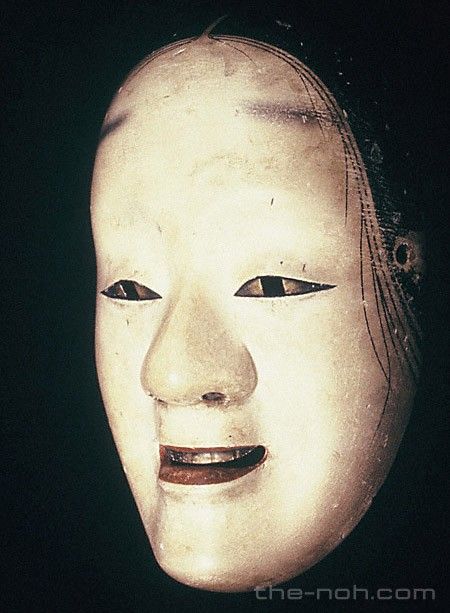
This wonderful (horror?) bridge section was also written into "The Story of Genji: Weng (Onmyoji's Biography)" by Dream Pillow Tapir, and interested friends can also read it.
In addition to the representative mud eye, in fact, the generation can be subdivided into five types of generation. The degree of anger and resentment is: Spawn > Dragon Girl* > Hashihime and Iron Wheel Girl** > Mud Eye.
Among them, the "generation" is different from the other four: at this stage, short horns and sharp teeth have grown, and the corners of the mouth have begun to crack and begin to have the appearance of a ghost.
According to the records, the reason why this face is called "generation" is because " a face that is slightly less than Prajna, and the corner begins to "generate" ". In other words, what it depicts is the moment just before Prajna. (Probably the last 0.001 seconds before your girlfriend or wife explodes)
*Honestly, I'm a little unsure of where Dragon Girl is in the five categories, since she doesn't have long horns, and at first glance is actually angrier than Hashihime. The allusion is a ghost girl who threw herself into a river because of jealousy and just turned into a ghost. It is characterized by the redness around her eyes, showing an uncomfortable atmosphere. However, when I was looking for information, there were books that said that they were more angry than Hashihime and Kanewa, so I arranged them like this for the time being. Anyway, pending.
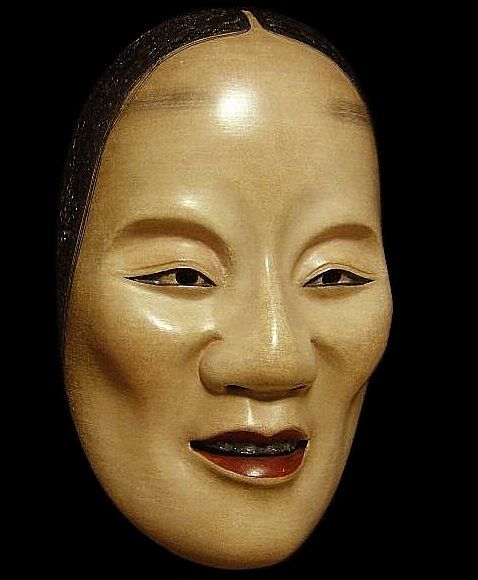
**Iron Wheel Girl's mask has the opera "Iron Wheel" of the same name. She is the kind of female figure that everyone is quite familiar with: at night (ugly: 1:00 to 3:00 in the morning), wearing a red dress, painting her face red, holding a hammer, nails, and a straw man to the trunk of the Kibune Shrine and nailing the grass People, cursed mistresses or heartbreakers. It got its name from the candlestick with an upside-down iron wheel (a rack used to set fire bowls in ancient times) on its head.
The protagonist of "Iron Wheel" is the famous Abe Seimei. The content is that a man who wants to marry a new love has nightmares every day and goes to Seimei to discuss it. As a result, he was told that the abandoned ex-wife became a ghost girl because of jealousy, and planned to curse him and the woman he was about to marry. If you don't deal with it, you will die tonight. In the end, the Great Onmyoji summoned the guardian gods and lined up to attack the ghost girl in a row (blame her. ←I don’t know why imagining that picture is a bit funny), and the ghost girl whowas thought to be mentallyweakened retreated and branded a cruel word: Wait for me another day!
By the way, Dream Pillow Tapir's Onmyoji series, Volume 11 "Three-legged Iron Ring" also bears the name of Iron Wheel Girl, but the plot is completely different. In addition, Kibune Shrine has long prohibited anyone from going in at midnight to nail grass people.If you have someone you want to curse, please nail them in your own home. www


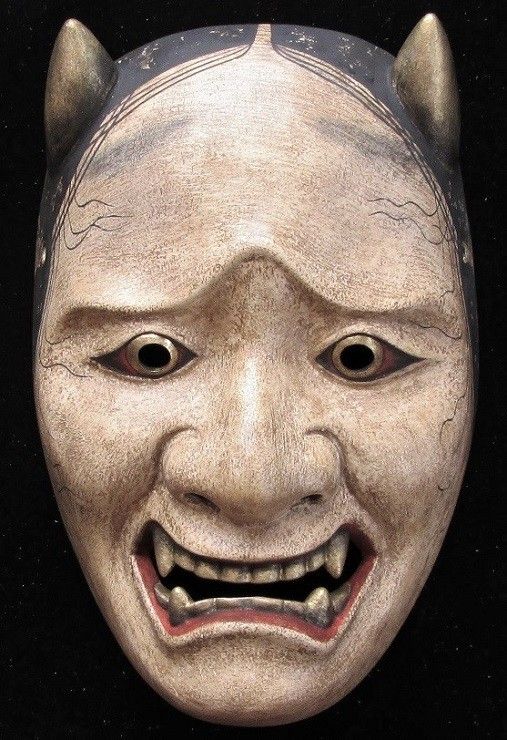
However, an interesting point needs to be added: in extreme anger and jealousy, women who become ghosts after being converted by Buddhas and Bodhisattvas also use "mud eyes" ("Dragon Girl (りゅう)" in "Sea People/Hai Shi"にょ)" also belongs to this category).
What it expresses is: the demonic energy still floats on the woman's face lightly, but at the same time, it can be seen that after this anger, gentle eyes gradually appear.
② Zhongcheng: The anger that was originally suppressed when it was born burst out in one breath . The representative work is the well-known "prajna" (はんにゃ). (In addition, Anda girl (あだちおんな) also belongs to the prajna category)
At this time, Nomen still had some hair, but the originally feminine silhouette began to be sharp and square. Eyes bulge out of anger, longer horns grow further on the head, teeth spew out from the grinning mouth, and the eyebrows disappear. At this point, the eyes, mouth, and the corners of the head will be painted gold. Described as a supernatural ghost* under intense jealousy/anger/hatred.
*Different from Chinese ghosts is that Japanese ghosts have a body, and there are ghosts born from ghosts and ghosts formed by human emotions. It is closer to the posture of the so-called Ashura path in Buddhism.
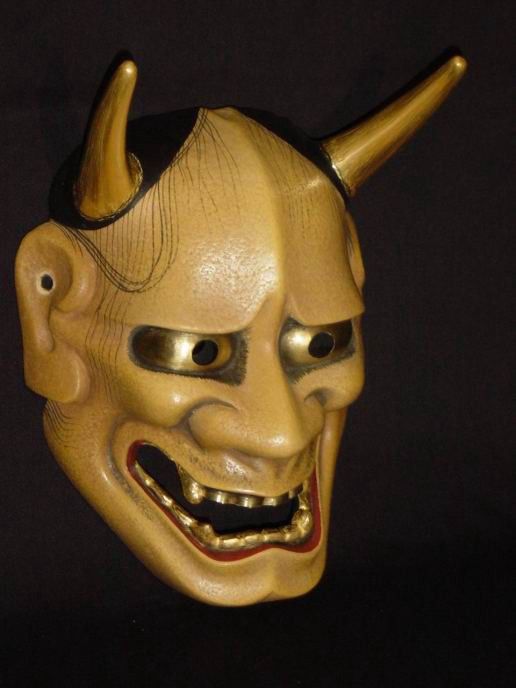
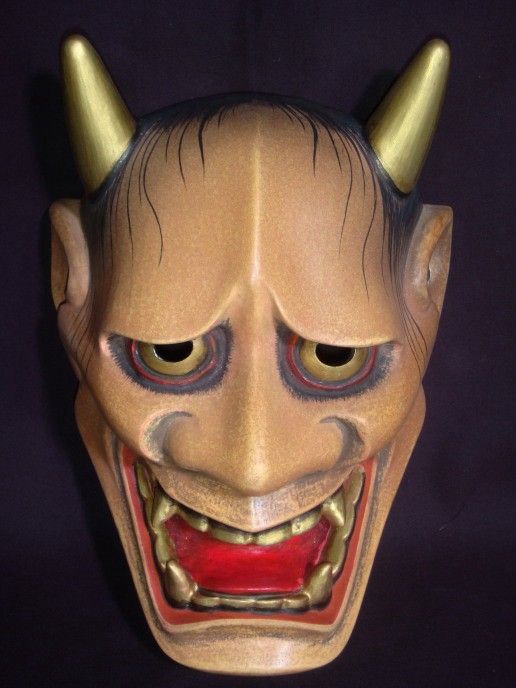
The previous scene of "Kwai Shang" mentioned above used mud eyes . However, when the monks hired by Genji began to recite the Prajna Sutra in an attempt to expel the evil spirits, the Sixth Imperial Palace switched to the Prajna plane , symbolizing that the souls were provoked and further entered the ghost realm.
Having said that, the Sixth Imperial Palace of <Kwai Shang> was successfully purified in the form of Prajna.
In order to further illustrate the evolutionary relationship "true success" of the next level of the Wraith Mian, let's take a look at another story that also uses the Prajna Mian: 〈Docheng Temple〉 (どうじょうじ)* .
"Doseiji Temple" also has "Nyoseiji Temple" written as joruri (puppet show) and kabuki.
The content of the story itself is very bizarre. To be honest, I still don't understand the logic of this story. But it has an undoubted importance as a classic repertoire of traditional Japanese drama.
"Doseiji Temple" describes an ultra-beautiful monk (!!!) Anzhen who went to Kumano from Shirakawa, Oshu, to visit a shrine, and met a woman, Kiyohime, at a hotel. There are different opinions about Qingji's background. Some say that she was divorced and returned to her parents' home to help run the hotel, while others say that she is an unmarried girl. But in short, Qingji fell in love with Anzhen at first sight, and the whole thing was overwhelmed.
Although the other party was a monk, she forced her to marry in every possible way, and she would not quit. In the story, it seems that An Zhen didn't even touch her finger at all, and was entangled by a "slutty" (female idiot).
But no matter how much An Zhen rejects Qing Ji, she is unwilling to give up (nor let him go). So Anzhen tricked Qingji into marrying her when he returned from his visit. When Qing Ji heard this, of course she happily sent An Zhen away.
Unexpectedly, after Anzhen returned from her visit, she secretly took a detour and left.
Waiting left and right, counting the time, the more she thought about it, the more wrong Qingji began to go out to find An Zhen, only to find out An Zhen's lie after asking passers-by. The two of you chased me all the way to the bank of Hidaka River. Because An Zhen left her to cross the river on her own, her strong anger turned her into a big snake and chased An Zhen. An Zhen finally escaped into the Daocheng Temple, and found a big bell to cover herself in it to hide. Qing Ji found the bell, wrapped the big bell with the body of a snake, spit fire, and burned An Zhen alive. Afterwards, Kiyohime escaped into the Hidaka River in the shape of a large snake and disappeared.
After reading some Japanese comments, I found that although An Zhen in the story is very unfortunate, the one who was deeply sympathized and discussed was unexpectedly Qing Ji? I don't know if Japanese Buddhism has a low sense of taboo on the marriage of monks? Or do they think that all this is the cause and effect of a previous life, and An Zhen should just go with the flow? Anyway, I still don't get it XD".
*Ancient picture scrolls/comics (?) "Dojoji Temple" go here: http://www.dojoji.com/anchin/etoki.html
In short, the first Noh face used by Kiyohime in "Doseiji Temple" is Prajna .
Originally in Sanskrit, "prajna" ((रज्ञा, Prajñā) means "(wisdom) wisdom".
In the end, why did Prajna become the name of a ghost that symbolizes the extreme anger and hatred of women in Japanese Noh dramas? There are two theories here. One is that the works of art created by the monk Prajna who lived in Nara during the Muromachi period were named after him. The second is to borrow the name of "wisdom" in Buddhism, thinking that this face needs to be created with wisdom.
But another guess of mine is: Prajna is the most commonly used expression of "attachment" in Noh dramas. (Although the snake/real snake is more advanced than it, but it is less used) If we think from the two sides of Buddhism's "afflictions are Bodhi ", is it not the moment of extreme attachment, pain, and trouble that is closest to the moment of enlightenment? This point can also be seen from the fact that after Prajna is transformed, it will return to the mud eye, which means that after the ultimate enlightenment of troubles, the trajectory of the ghost's disappearance can be seen.
③ Zhencheng: This stage can be regarded as the evolutionary complete body of "anger + hatred MAX" . "Snake" and "true snake" fall into this category. At this stage, the entire mask will be painted gold (or red for intense rage), representing the complete loss of humanity (6th layer of Abyss, welcome!). The eyebrows are gone, and some even have their hair gone. The appearance is ferocious, like a snake with a big mouth open.
Snake and Prajna are actually very similar. If you search on Japanese websites, you will find that even Japanese people can confuse them.
But in fact, the key to the two is that only the snake has "disappeared ears" , which means that the female character who has completely lost her humanity can no longer listen to anyone, and it is useless to say anything to her. However, ordinary Noh dramas seem to rarely use this stage, and the most intense is Prajna. Therefore , the most representative snake face is the second Noh face used by Kiyohime of "Doseiji Temple ".
(It's also a pinch, so there are not many orz|||)
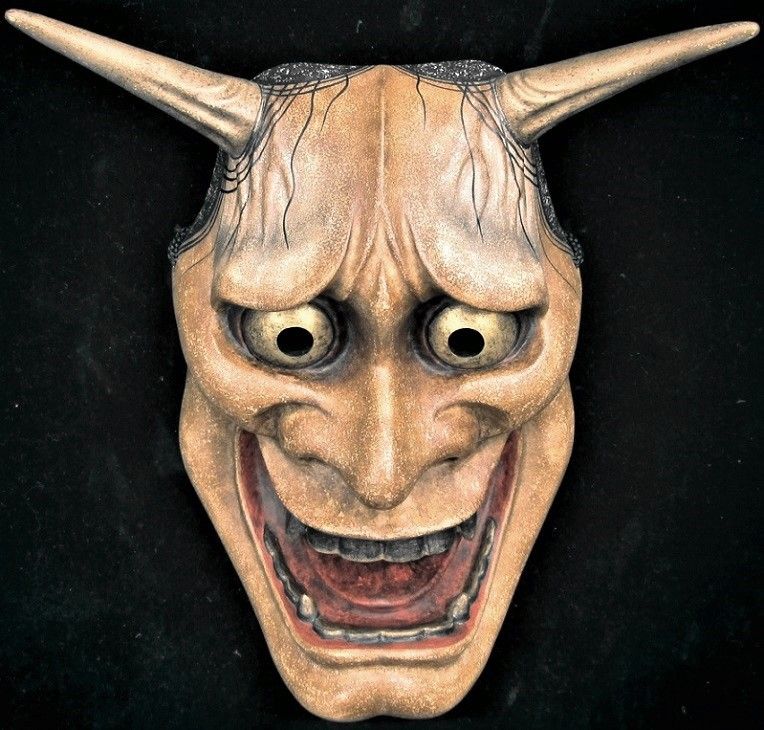
(This may be an old wisdom of "If your queen is already mad, it is recommended that you don't talk nonsense" or not necessarily www)
Here we can find that in the same opera, the energy surface will also be changed according to the mood changes. "Kwai Shang" uses mud eyes and prajna, "Iron Wheel" uses mud eyes, Hashihime, and Sheng, and "Daocheng Temple" uses prajna and real snakes.
Speaking of which, why are women who show the strongest jealousy and hatred in Nomen? Of course, the people who created Noh back then should all be men. For them, women's anger is horrific and incomprehensible. If it is said that Noh is biased against women, it is indeed to blame.
But going back to the era when Noh was born, many of Noh's writings were stories of grievances and grievances between nobles or ghosts. As a noble woman, most of them are required to be reserved and dignified in their upbringing. On the other hand, noble women in the Heian period still had to rely on their fathers, brothers and husbands to live in principle. If they were neglected or abandoned by their husbands, they would not only be emotionally frustrated, but even their lives would be in crisis.
Therefore, this oppressive upbringing also contributed to the opportunity for women in Noh dramas to turn into ghosts: at the moment when the desire to be loved but hopeless, when the balance between restraint and the self is out of balance, the fire of hell hidden in human nature The parties will be burnt out.
I think the stage of prajna or real snake is not so much a supernatural state as it hides a kind of Buddhist vigilance. As mentioned in the origin of the Emperor Liang's Treasure Repentance: those with strong hatred will be reincarnated as snakes. It's just that Japan, which was founded on Buddhism in ancient times, further used this metaphor in Noh dramas, symbolizing the intensity of emotions and the depth of sin.
Therefore, the revelation of prajna or snake face should not only be aimed at women, but "both men and women" should be careful with their own minds and open their ears to listen to others, so as not to fall into sin. Thinking about the men who commit murders with knives in pursuit of rejection, aren't they also the embodiment of real snakes?
Like my work? Don't forget to support and clap, let me know that you are with me on the road of creation. Keep this enthusiasm together!

- Author
- More